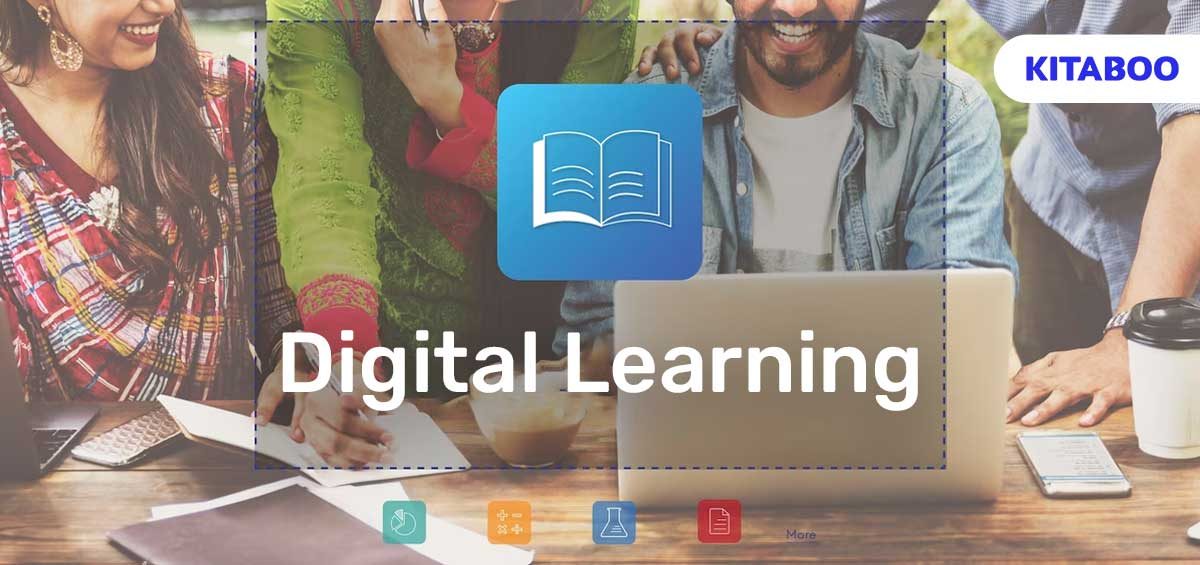Students of all ages have now become a part of the digital learning and education transformation. Traditional classrooms are a thing of the past now, and the new age of technologically advanced classrooms is dominating the K-12 education industry.
These modern-day classrooms demonstrate a dynamic amalgamation of technology and education. The resultant high-quality and comprehensive learning outcomes have further deepened the role of digital learning in K-12 education.
Table of Content
- Learning Management Systems (LMS)
- Gamification and Virtual Learning
- Flipped Classrooms
- Massive Open Online Course (MOOC)
- Hybrid Learning
III. Benefits of Digital Learning
- Enhanced Inclusivity and Accessibility
- Numerous Personalization and Customization Options
- Greater Scalability and Flexibility
- More Environmentally Friendly and Sustainable
IV. Tips for Adopting Digital Learning Tools
V. Wrapping Up
What is Digital Learning?
Digital learning is a type of learning which is enabled by digital technological tools and apparatuses. It is also known as online learning or e-learning because the learning experience is facilitated using a wide range of tools over the internet.
Another common way of referring to digital learning is flipped learning because it has transitioned traditional classrooms into modern-day virtual classrooms.
A lot of digital platforms are now offering digital and e-learning solutions to help students engage with such modern-day virtual classrooms. Some of these interactive platforms are KITABOO, LinkedIn Learning, Coursera, etc.
Types of Digital Learning
Digital learning can be employed in a variety of ways depending on the preferences and needs of the learners. K-12 students have a wide range of syllabi to cover.
Therefore, educators and teachers utilize digital learning tools that promise the best content-specific learning outcomes.
Learning Management Systems (LMS)
The learning management system (LMS) is a centralized hub that allows educators and teachers to plan, create, and publish e-learning content. The platform comes with numerous features and functionalities to effectively manage digital material and keep students positively engaged.
Some of the features of LMS are personalization and customization, data analytics and reporting, data tracking, offline learning, mobile compatibility, and much more.
Also Read: Best eBook Hosting Platforms for Digital Publishing
Gamification and Virtual Learning
Gamification and virtual learning is a highly engaging and creative digital learning option for K-12 students as it incorporates various gaming elements. This makes learning highly enjoyable for the students and encourages them to spend more time learning.
Some of the common gaming elements are immersive virtual races, pop-up quizzes, badges, etc. The recent advanced technological tools like artificial intelligence and machine learning have further advanced the potential of virtual gamification.
Flipped Classrooms
In flipped classrooms, traditional classroom teaching approaches are swapped with modern-day digital learning. For instance, students are taught using video lectures, interactive presentations, and other kinds of digital content.
The in-class projects and assignments are also planned around hands-on activities that utilize virtual learning parameters. A flipped classroom goes a long way in successfully bridging the gap between theoretical understanding and practical implementation of knowledge for K-12 students.
Massive Open Online Course (MOOC)
Massive open online courses are not just effective for K-12 education but for learners across various age groups and industries. These are open online courses that are available on the internet for free participation and learning opportunities.
All kinds of learners, like K-12 students, university students, teaching assistants, professionals, working professionals, etc., benefit from these open-access courses.
Hybrid Learning
Hybrid learning, also known as blended learning, combines traditional and modern learning. Various technology-based instructional methods are implemented in the physical classroom space to provide the students with personalized learning.
Hybrid learning has been widely adopted after the global pandemic to ensure student learning continues uninterrupted during unavoidable situations and circumstances.
Benefits of Digital Learning
Enhanced Inclusivity and Accessibility
Learners, irrespective of geographical locations, time constraints, personal responsibilities, etc., can access education at their convenience with the help of digital learning apparatuses. Even learners with mobility issues or other cognitive impairments can access a variety of learning materials through an efficient learning process.
Keeping accessibility in mind, KITABOO – the digital textbook platform, for instance, offers interactive and inclusive features like text highlighting, annotating, font resizing, backlight adjustment, and more.
Numerous Personalization and Customization Options
Each learner, particularly K-12 students, has varied kinds of learning and growth requirements. In a traditional classroom, it often becomes difficult for a single teacher to cater to all the students singularly at once.
With digital learning, the learning material can be easily customized for each student from the very beginning. The numerous personalization and customization features of digital learning tools and platforms take into consideration the strengths and weaknesses of each learning efficiently.
Greater Scalability and Flexibility
The features and functionalities of digital learning tools and platforms are highly extendable. For instance, during the pandemic, digital learning platforms advanced radically to accommodate a large number of students.
The continually evolving digital landscape plays a significant role in making improvements in the learning curriculum and approaches. Additionally, the data analytical techniques of digital learning also enhance the decision-making capabilities of educators, gradually leading to enhanced scalability and flexibility.
More Environmentally Friendly and Sustainable
Digital learning has significantly reduced the need to utilize physical resources like paper, ink, plastic, water, and more.
For instance, learners need to take out paper printouts for studying reading material, homework, and more. Digital learning techniques are much more environmentally friendly and sustainable than traditional teaching methods.
Tips for Adopting Digital Learning Tools
Here are some tips you can keep in mind for adopting digital learning tools:
- Clearly identify the desired learning outcomes and objectives
- Assess the learning proficiency and skills of your learners
- Research the features and functionalities that are rightly adaptable and scalable
- Select the digital learning tools best suited for your needs
- Provide adequate training to the staff, educators, and learners using the tool
- Gather feedback and incorporate it for improvement
- Do pilot testing before launching the tool for your learners
- Blend digital tools with traditional learning methods
Wrapping Up
It is safe to say that incorporating digital learning tools in K-12 education can go a long way in enhancing learning outcomes and fostering a positive learning environment for your learners. If you are thinking about adopting digital learning, now is the right time to dive into it. It will prove to be highly beneficial and revolutionary for you and your learners.
If you need help with the same, you can reach out to KITABOO – the digital textbook platform. With our digitally advanced services, you can achieve educational excellence and take your K-12 education to great heights. We have a trusted customer base globally, and you can be our next customer.
Reach out to our expert team now. Hope to see you soon!
To know more, please write to us at KITABOO@hurix.com.
Suggested Reads:
Discover How An Ebook Conversion, Publishing & Distribution Platform Can Help You
Kitaboo is a cloud-based content platform to create-publish & securely distribute interactive mobile-ready ebooks.
You May Also Like








